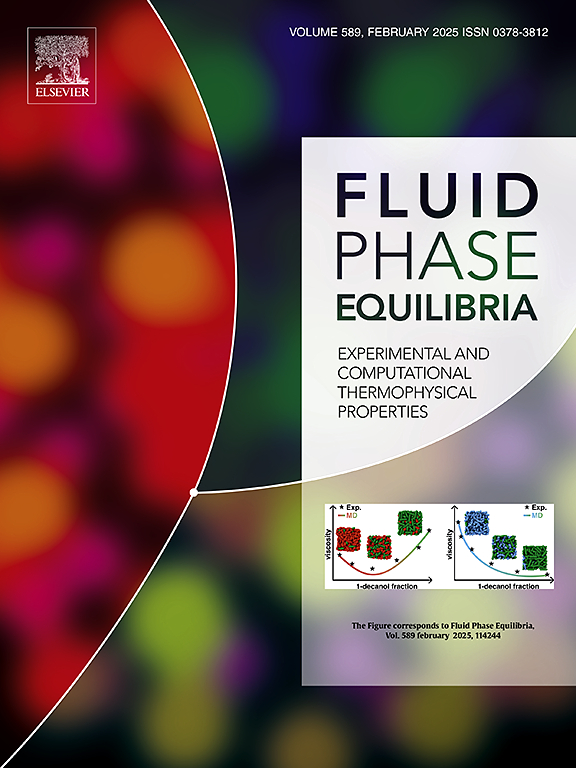Solving the UVN-flash problem in TVN-space
IF 2.7
3区 工程技术
Q3 CHEMISTRY, PHYSICAL
引用次数: 0
Abstract
In this paper, we investigate the phase equilibrium problem for multicomponent mixtures under specified internal energy (), volume (), and mole numbers (), commonly known as the UVN-flash problem. While conventional phase equilibrium calculations typically use pressure–temperature-mole number () specifications, the UVN formulation is essential for dynamic simulations of closed systems and energy balance computations. Existing approaches, including those based on iterative pressure–temperature updates and direct entropy maximization, can suffer from computational inefficiencies due to inner Newton iterations needed to solve for temperature at specified internal energy and volume .
In this work, we present a reformulation of the UVN-flash problem that eliminates the need for the inner Newton iterations, addressing a computational bottleneck. We begin with stability analysis and discuss a strategy to generate the initial guess for the UVN-flash from the stability analysis results. We then reformulate the UVN-flash problem in TVN-space as constrained entropy maximization. We provide a detailed derivation of Michelsen’s Q-function using the method of Lagrange multipliers, illustrating its direct application in solving the UVN-flash problem. Furthermore, we discuss the numerical methods used, including gradient and Hessian computations. The reformulation is validated against benchmark cases, demonstrating improved efficiency.
解决了电视空间的uvd -flash问题
本文研究了给定内能(U)、体积(V)和摩尔数(N1,N2,…,Nn)条件下多组分混合物的相平衡问题,即通常所说的uvn闪蒸问题。虽然传统的相平衡计算通常使用压力-温度-摩尔数(PTN)规格,但UVN公式对于封闭系统的动态模拟和能量平衡计算至关重要。现有的方法,包括基于迭代压力-温度更新和直接熵最大化的方法,由于在特定内能U和体积v下求解温度T需要内牛顿迭代,可能会导致计算效率低下。在这项工作中,我们提出了一种重新表述的UVN-flash问题,消除了对内牛顿迭代的需要,解决了计算瓶颈。我们从稳定性分析开始,讨论了一种从稳定性分析结果中产生uvn闪光初始猜测的策略。然后,我们将tvn空间中的UVN-flash问题重新表述为约束熵最大化问题。我们用拉格朗日乘子法给出了Michelsen q函数的详细推导,说明了它在解决UVN-flash问题中的直接应用。此外,我们讨论了所使用的数值方法,包括梯度和Hessian计算。通过对基准案例的验证,证明了改进的效率。
本文章由计算机程序翻译,如有差异,请以英文原文为准。
求助全文
约1分钟内获得全文
求助全文
来源期刊

Fluid Phase Equilibria
工程技术-工程:化工
CiteScore
5.30
自引率
15.40%
发文量
223
审稿时长
53 days
期刊介绍:
Fluid Phase Equilibria publishes high-quality papers dealing with experimental, theoretical, and applied research related to equilibrium and transport properties of fluids, solids, and interfaces. Subjects of interest include physical/phase and chemical equilibria; equilibrium and nonequilibrium thermophysical properties; fundamental thermodynamic relations; and stability. The systems central to the journal include pure substances and mixtures of organic and inorganic materials, including polymers, biochemicals, and surfactants with sufficient characterization of composition and purity for the results to be reproduced. Alloys are of interest only when thermodynamic studies are included, purely material studies will not be considered. In all cases, authors are expected to provide physical or chemical interpretations of the results.
Experimental research can include measurements under all conditions of temperature, pressure, and composition, including critical and supercritical. Measurements are to be associated with systems and conditions of fundamental or applied interest, and may not be only a collection of routine data, such as physical property or solubility measurements at limited pressures and temperatures close to ambient, or surfactant studies focussed strictly on micellisation or micelle structure. Papers reporting common data must be accompanied by new physical insights and/or contemporary or new theory or techniques.
 求助内容:
求助内容: 应助结果提醒方式:
应助结果提醒方式:


